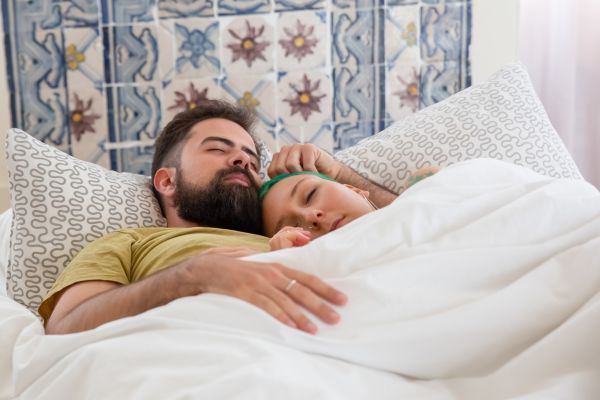Sharing a bed with the one you love can be a wonderful experience, but it can also come with its fair share of challenges. One common issue that many couples face is disagreeing about sleep temperature. Here is some help for couples who disagree about sleep temperature.
Picture this: a couple, cozying up for a night’s sleep, only to be disrupted by the ever-lingering debate over the ideal sleep temperature. It’s a dilemma that countless couples face, and it’s more than just a minor disagreement. The battle between the “too hot” and the “too cold” can disturb sleep, cause frustration, and strain relationships. If you find yourself nodding in agreement, you’re not alone.
In this article, we’ll explore practical solutions for couples who find themselves on opposite ends of the sleep temperature spectrum.
Help For Couples Who Disagree About Sleep Temperature
Sleep temperature preferences are as unique as fingerprints. We all have that sweet spot where we feel most comfortable, but finding it can be a challenge. Imagine one partner feeling like they’re in a sauna while the other is shivering beneath the covers.
This divide is not only about personal comfort; it’s rooted in physiological differences. Metabolism, body composition, and hormonal factors play a role in how we perceive and regulate temperature.
Communication is Key
The first step towards resolving any disagreement is communication. Instead of bickering under the covers, initiate an open and honest conversation about your sleep temperature preferences.
Discuss how the issue is affecting both of you and emphasize that finding a solution is a mutual goal. Avoid blame or accusations, and focus on understanding each other’s needs.
The most crucial step is open communication. Discuss your temperature preferences with your partner. Share your concerns, and listen to theirs. Understanding each other’s needs is the first step toward finding a compromise.
Compromise and Finding Middle Ground
Compromise doesn’t mean sacrificing comfort. In a relationship, compromise is essential. Try to find a middle ground that both you and your partner can agree on. This may involve adjusting the thermostat to a temperature that suits both of you.
It’s about finding a solution that caters to both partners’ needs. Consider dual-zone bedding options that allow separate temperature controls for each side of the bed. This way, you can enjoy your preferred sleep environment without encroaching on your partner’s comfort.
Bedroom Environment Optimization
Optimizing your bedroom environment can have a significant impact on sleep quality. Ensure your thermostat settings are conducive to a comfortable sleep temperature.
If one partner prefers a cooler environment, a fan or extra blankets can provide the needed warmth without affecting the other’s preference.
Innovative Bedding Solutions
Thanks to technology, there are innovative bedding solutions available. Smart bedding with adjustable temperature settings can be a game-changer. These products allow you to customize your side of the bed to your ideal temperature, without affecting your partner’s side.
Personalized Sleep Spaces
Creating personalized sleep spaces within a shared bed can also alleviate the issue. Separate blankets, or even sleeping pods, can cater to individual temperature preferences without sacrificing physical closeness.
Fabric and Material Choices
The choice of bedding materials can greatly influence temperature regulation. Opt for breathable fabrics that prevent overheating or excessive coldness. Natural materials like cotton and bamboo are excellent choices for maintaining a comfortable sleep environment.
Sleep Hygiene and Routine
Maintaining a consistent sleep routine can indirectly impact your sleep temperature preferences. Engaging in calming bedtime rituals can help regulate your body’s internal clock, which in turn affects how your body perceives and responds to temperature changes.
Temperature-Related Sleep Disorders
Sometimes, sleep temperature disagreements are symptoms of underlying sleep disorders. Conditions like insomnia or night sweats can exacerbate the issue. If sleep quality is significantly affected, seeking professional guidance from a sleep expert or therapist is recommended.
Experimentation and Adaptation
Preferences can change over time, so don’t be afraid to experiment with different solutions. What worked perfectly last winter might not be suitable now. Be open to adaptation and willing to adjust your approach as needed.
Sometimes, it might take a bit of trial and error to find the perfect sleep temperature compromise. Be patient and willing to make adjustments until you both feel comfortable.
Professional Guidance
If the issue continues to escalate, consider seeking professional help. Sleep experts and therapists can provide tailored advice and strategies to address the underlying concerns causing sleep temperature disagreements.
Case Studies and Success Stories
Real-life success stories can be inspiring. Couples who’ve overcome similar disagreements share their strategies and experiences. These anecdotes shed light on the journey towards finding harmony in sleep temperature preferences.
Maintaining Intimacy
One concern that arises with separate sleep arrangements is the potential impact on intimacy. It’s important to remember that physical proximity isn’t the only way to maintain emotional closeness. Communicate your needs and find ways to engage in meaningful connection outside of the bedroom.
Conclusion
Sleep temperature disagreements might seem trivial, but they can have a substantial impact on a relationship’s quality. By embracing open communication, compromise, and innovative solutions, couples can bridge the gap between their differing preferences. Remember, a good night’s sleep is a shared goal, and finding common ground in the bedroom can lead to a happier, healthier partnership.
FAQs About Sleep Temperature Disagreements
1. Is there a universal “ideal” sleep temperature? While there isn’t a one-size-fits-all answer, a typical range between 60-67°F (15.5-19.4°C) is often considered comfortable for sleep.
2. Can external factors affect sleep temperature preferences? Yes, factors like room humidity, clothing, and even stress levels can influence how you perceive and regulate temperature during sleep.
3. Are there any natural ways to regulate body temperature for better sleep? Yes, practicing relaxation techniques, maintaining a consistent sleep schedule, and staying hydrated can all contribute to improved temperature regulation.
4. Do weighted blankets help with sleep temperature disagreements? Weighted blankets can provide a sense of coziness, but they might not directly solve temperature disagreements. Consider using dual-zone bedding or breathable fabrics alongside a weighted blanket.
5. Is it okay for couples to have separate blankets or sleep spaces? Absolutely. What matters most is the quality of sleep and the health of the relationship. Separate sleep arrangements can be a practical solution that maintains harmony.







